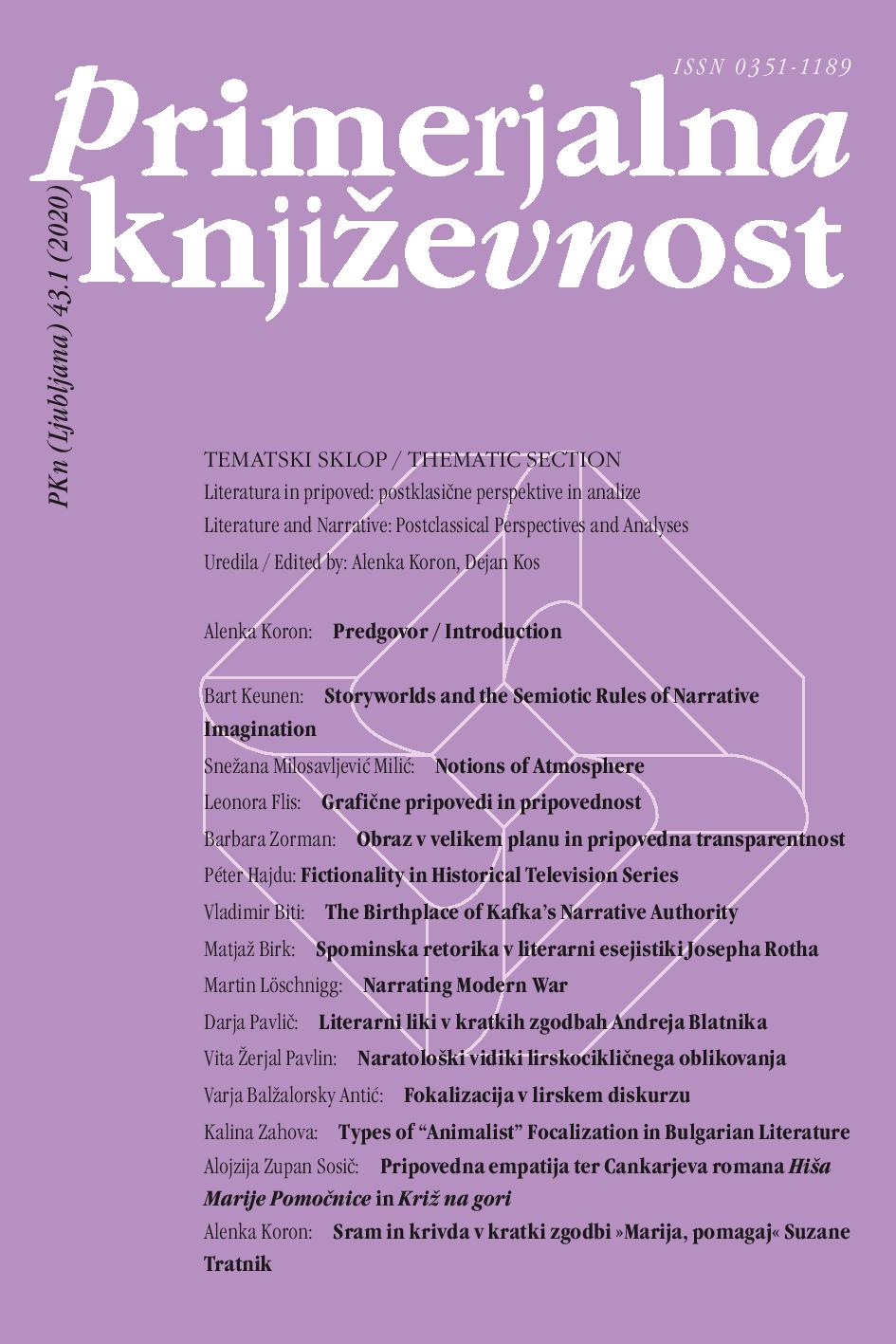The Face in Close-Up and Narrative Transparency
DOI:
https://doi.org/10.3986/pkn.v43.i1.04Keywords:
film theory, cognitive science, narratology, face on film, film characters, Slovenian film, mask, Biček, RokAbstract
In its first part, the article compares various theoretical insights into the topic, beginning with Balázs’s claim that the magnification and proximity of the face in close-up replace narrative movement, i.e. action, with micromovement that represents subjectivity. For Deleuze, the face in close-up is deterritorialized into the “feeling-thing,” the entity as the set-up of the affect. For Deleuze, the close-up abstracts the face from its bearer. Furthermore, the film face as a mask is presented (Barthes). Besides the metaphor of the cinema as a mirror within psychoanalytical film theory, the insights of the cognitive film theory are analyzed, particularly the function of the face in the “scenes of empathy” (Plantinga). The second part examines the role of the face in Rok Biček’s first feature film Razredni sovražnik (Class Enemy, 2013), which presents the revolt of a class against an authoritative teacher following the suicide of their classmate Sabina. This film exposes the opaqueness of the face most notably in the representation of Sabina’s face, particularly as it is presented within the context of her friend’s mental images, memories. But the mysteriousness of her face is most prominent in the masks created from the photography of Sabina’s face that her classmates put on in an act of rebellion against their teacher. Sabina’s face is the film’s blind spot: although completely exposed to our gaze, its meaning remains ambiguous, even unattainable. Such representation seems to reject the face as “an instrument of signification” (Eleftheriotis).
References
LITERATURA
Balázs, Béla. Der sichtbare Mensch: oder Die Kultur des Films. Frankfurt: Suhrkamp Verlag, 2001. Tudi na spletu. Dostop na naslovu https://epdf.pub/der-sichtbaremensch-oder-die-kultur-des-films.html. Dostop 22. 1. 2020.
Balázs, Béla. Theory of the Film (Character and Growth of a New Art). Prev. Edith Bone. London: Dennis Dobson Ltd., 1952.
Barlič, Špela. »Razredni sovražnik je vsaj srednjeevropska zgodba«. Intervju z Rokom Bičkom. Pogledi 13. 9. 2013. Tudi na spletu. Dostop 10. 1. 2020.
Barthes, Roland. »Obraz Garbo«. Prev. Polona Poberžnik. Časopis za kritiko znanosti 31.212 (2003): 94–95. Tudi na spletu. Dostop 12. 1. 2020.
Bellow, Saul. Herzog. Prev. Mira Mihelič. Ljubljana: Delo, 2004.
Brener, Milton E. Evolution and Empathy: The Genetic Factor in the Rise of Humanism. Jefferson, N. C.: McFarland & Co., 2008.
Deleuze, Gilles. Podoba-gibanje. Prev. Stojan Pelko. Ljubljana: ŠKUC in Znanstveni inštitut Filozofske fakultete, 1991.
Eleftheriotis, Dimitris. »Cosmopolitanism, Empathy and the Close-Up«. The Routledge Companion to Cinema and Politics. Ur. Yannis Tzioumakis in Claire Molloy. London in New York: Routledge, 2016. 209–225.
Elsaesser, Thomas in Hagener, Malte. Teorija filma: uvod skozi čute. Prev. Polona Petek. Ljubljana: Slovenska kinoteka, 2015.
Girimonti Greco, Giuseppe. »‘Adoratori’ romanzeschi della Garbo: (de)figurazioni narrative di un volto divino (1933–2007)«. L’immagine ripresa in parola: letteratura, cinema e altre visioni. Ur. Matteo Colombi, Stefania Esposito in Massimo Fussilo. Rim: Meltemi, 2008. 145–169.
McGilchrist, Iain. The Master and His Emissary. New Haven in London: Yale University Press, 2012.
McNeill, Daniel. The Face: A Natural History. Boston, New York in London: Little, Brown and Company, 2000.
Mitchell, W. J. Thomas. What Do Pictures Want?: The Lives and Loves of Images. Chicago: The University of Chicago Press, 2005.
Plantinga, Carl. »The Scene of Empathy and the Human Face on Film«. Passionate Views: Film, Cognition, and Emotion. Ur. Carl Plantinga in Greg M. Smith. Baltimore: Johns Hopkins University Press, 1999. 239–256.
Plantinga, Carl. »Facing Others: Close-Ups of Faces in Narrative Films in The Silence of the Lambs«. The Oxford Handbook of Cognitive Literary Studies. Ur. Lisa Zunshine. Oxford in New York: Oxford University Press, 2015. 291–312.
Pudovkin, Vsevolod Illarionovich. Film Technique and Film Acting: The Cinema Writings of V. I. Pudovkin. Prev. Ivor Montagu. London, Vision Press Limited, 1954.
Shakespeare, William. Shakespeare: Complete Works. Ur. W. J. Craig. London: Oxford University Press, 1969.
Stankovič, Peter. Rdeči trakovi: reprezentacija v slovenskem partizanskem filmu. Ljubljana: Fakulteta za družbene vede, 2005.
FILMOGRAFIJA
Anderson, Lindsay, in Michael Medwin (producenta). Lindsay Anderson (režiser). If… VB: Memorial Enterprises.
Benjo, Caroline, Carole Scotta, in Barbara Letellier (producentke). Laurent Cantet (režiser). Entre les murs. Francija: Haut et Court, 2008.
Heiduschka, Veit, Michael Katz, in Margaret Menegoz (producenti). Michael Haneke (režiser). Caché. Francija, Avstrija, Nemčija, Italija: France 3 Cinéma, Canal+, Bavaria Film, Wega Film, 2005.
Karmitz, Marin (producent). Michael Haneke (režiser.) Code inconnu: récit incomplet de divers voyages. Francija, Nemčija, Romunija: Arte France Cinéma, Bavaria Film, Canal+, Filmex, France 2 Cinéma, Les Films Alain Sarde, MK2 Productions, Romanian Culture Ministry, Zweites Deutsches Fernsehen (ZDF), 2000.
Prosenc, Aiken Veronika, in Janez Lapajne (producenta). Rok Biček (režiser). Razredni sovražnik. Slovenija: Triglav film, 2013.
Wanger, Walter (producent). Rouben Mamoulian (režiser). Queen Christina. ZDA: Metro-Goldwyn-Mayer, 1933.


